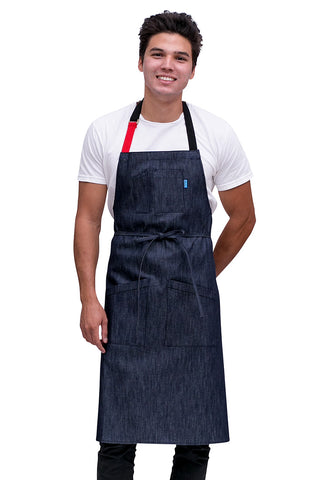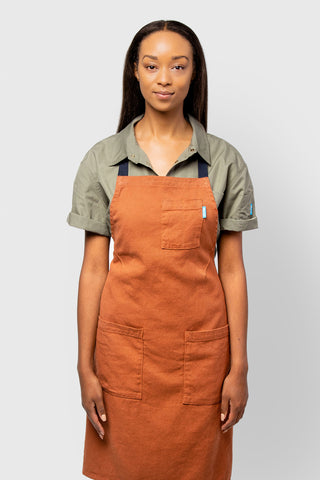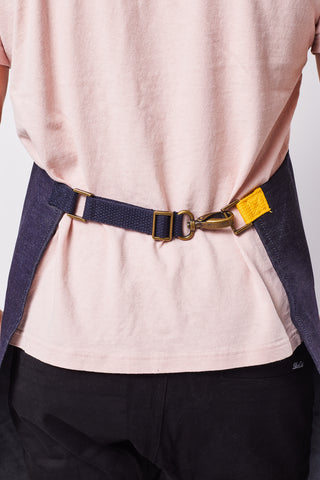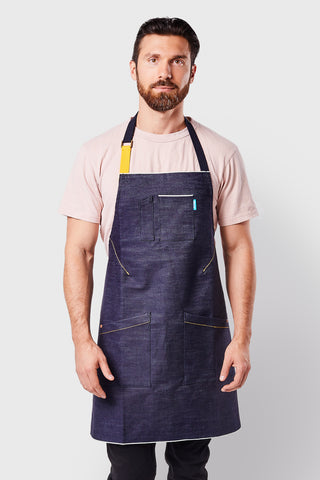Whether you have to wear one for work or just want protection for your clothes when you make meals at home, chef aprons are the perfect choice. They come in many styles and patterns, but they all need to be tied on securely to do their job well.
How do you wear a chef apron? In general, aprons are very simple to figure out. You put the top loop over your head and around the back of your neck, smooth the fabric over your front, and tie the straps somewhere around your waist. Despite the simplicity, it can still be a challenge to keep your store-bought or handmade aprons from coming undone or feeling uncomfortable.
This guide will tell you everything you ever wanted to know about how to comfortably wear an apron. It provides multiple options for both casual use and professional requirements and even different tying styles to get the perfect fit or look.
Tying the Neck Strap on a Cooks Apron
How do we keep an apron from pulling on my neck? Many people ask this question because it is very uncomfortable and distracting to have a strap putting pressure or rubbing on the back of your neck when you are trying to work or cook a meal.
Most high-quality aprons have adjustable neck straps with a slider in sturdy plastic or metal. If you choose a handmade apron that does not come with this slider, consider with a few stitches or a clip. Use this to adjust the fit so the top of the fabric rests across your chest comfortably. The right position will help prevent neck strap aggravation.
Tying an Apron Waist Strap in Four Ways
If you wear chef aprons for work, your employer may tell you where to buy cooking aprons that come with specific instructions about the style of knot you should use. However, if it is your choice, you have three main options for tying an apron.
Tie a Cooking Apron at the Front
While it is somewhat easier to tie an apron at the front, this is not recommended for chefs or anyone who will work with hot stoves or potentially dangerous machinery. Having the tie at the front does create dangling straps that could get caught or get dirty quickly.
If you do not have these issues, a front tie is your best option for quick and easy apron wearing.
- Adjust the neck strap first
- Grasp the waist straps behind your back in the opposite hands
- Bring the straps around in the front at waist height
- Tie them together in a simple bow
It might take a bit of practice to manage step #2 quickly. You can also try moving one strap at a time and tucking it under your arm until you have both of them in front.


Tie a Cooking Apron at the Front with the Straps Hidden
If you would like to hide the apron ties completely, you can adjust the body of the apron to conceal them. This is a safer option for those who work with hot stoves or potentially dangerous equipment. It also creates a more streamlined look.
- Adjust the neck strap first
- Grasp the waist straps behind your back in the opposite hands
- Lift the apron body up from bottom and hold with chin against your chest
- Bring the straps around in the front at waist height
- Tie them together in a simple bow
- Drop the body over the tie to hide the straps under the body of the apron


Learning how to tie an apron behind your back is a bit more challenging for some people. You need to be dexterous enough to make a bow or knot without being able to see it. This is something that gets easier over time.
Tying your cook’s apron behind you starts with the same basic steps outlined above. Adjust the neck properly and smooth out the fabric. Then, take the waist straps in the same side hands behind your back. Start with a simple first tie by crossing the straps and tucking one under and around the second. Then, create the bow loops and tie them together.


Tie a Korean Hanbok Ribbon Style
This unique ribbon knotting or bow style offers a sleek alternative to a simple bow. It is ideal for front of house uniforms where a leader and more professional look is helpful. The knot is commonly used with traditional Korean Hanbok outfits, but it can work well for a basic chef’s apron too.
- Adjust the neck strap first as usual
- Cross the waist straps in the back and pull each and around to the front as if you are going to tie a bow
- Tie a first tie to secure the straps by crossing them over each other and pulling one up from the back
- Wrap the top strap around your hand or fingers once to form a loop
- Bend the bottom strap near the first tie and draw this through the loop on your hand
- Adjust the small loop on the side while tightening the larger loop that was around your hand until it catches the strap securely
- Smooth both ends of the ribbon down the front of the apron neatly
This is a very quick and attractive way to tie an apron at the front. It may take a few tries to get it right, but it is worth it in the end.


How Do You Secure an Apron for Long-lasting Wear?
No matter which style you choose to tie your cooking apron in, the straps or ribbons could come loose if you do not tighten them appropriately. Always make sturdy bows or knots that are less likely to come apart when you do not want them to. However, since you need to remove your apron and put it back on frequently, you do not want to create a knot that will not come loose.
Consider a double bow instead. After creating a simple bow as described above, grab both of the large loops and tie them together in a first tie. Pull this securely and your bow will be much less likely to come loose in the middle of making a meal or serving customers.
Another option is to get an apron with a clasp back closure instead of a classic tie. This makes putting your chef’s apron on, keeping it secure, and taking it off again very easy.


For those who cook at home, an apron protects you from splatters in the kitchen. Professional chefs, line cooks, servers, front of house staff, and other workers who are required to wear aprons need a more polished appearance. These tips about how to tie an apron will help you look your best, stay comfortable, and satisfy all employer requirements with ease.
Shop the extensive line of BlueCut aprons to find your perfect style and fit. Now that you know how to tie an apron properly, you can protect yourself and your clothes while presenting a neat appearance to customers.


